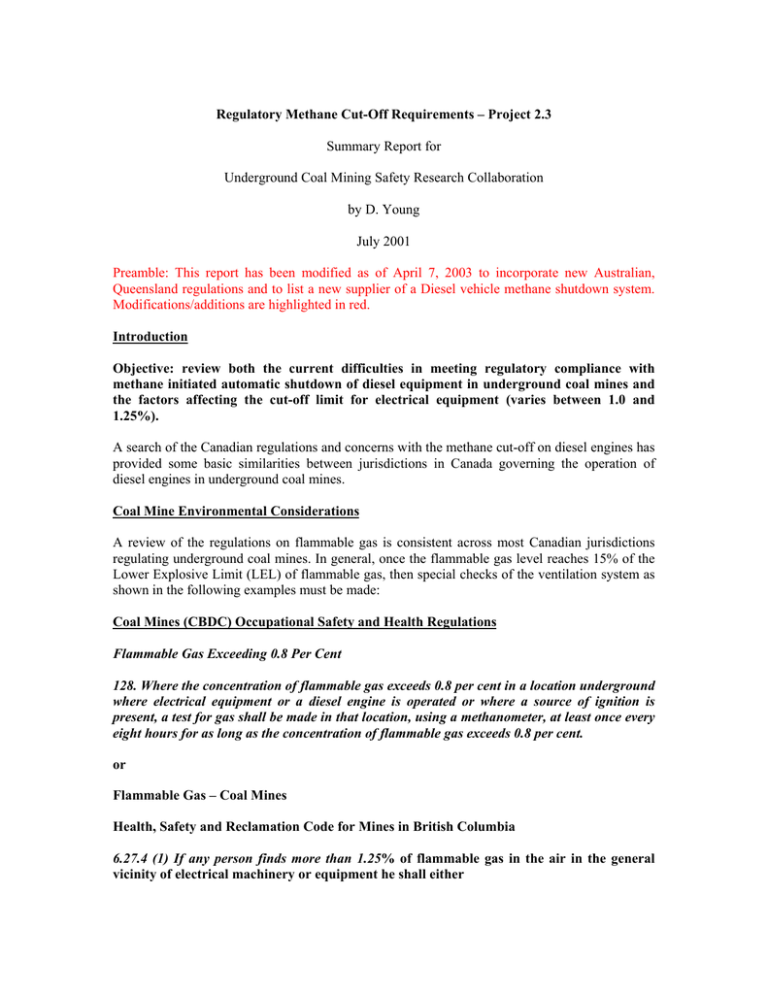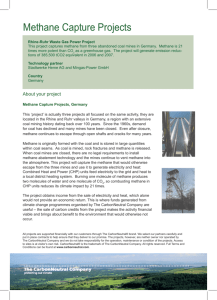Methane Cut-off Report - Underground Coal Mining Safety
advertisement

Regulatory Methane Cut-Off Requirements – Project 2.3 Summary Report for Underground Coal Mining Safety Research Collaboration by D. Young July 2001 Preamble: This report has been modified as of April 7, 2003 to incorporate new Australian, Queensland regulations and to list a new supplier of a Diesel vehicle methane shutdown system. Modifications/additions are highlighted in red. Introduction Objective: review both the current difficulties in meeting regulatory compliance with methane initiated automatic shutdown of diesel equipment in underground coal mines and the factors affecting the cut-off limit for electrical equipment (varies between 1.0 and 1.25%). A search of the Canadian regulations and concerns with the methane cut-off on diesel engines has provided some basic similarities between jurisdictions in Canada governing the operation of diesel engines in underground coal mines. Coal Mine Environmental Considerations A review of the regulations on flammable gas is consistent across most Canadian jurisdictions regulating underground coal mines. In general, once the flammable gas level reaches 15% of the Lower Explosive Limit (LEL) of flammable gas, then special checks of the ventilation system as shown in the following examples must be made: Coal Mines (CBDC) Occupational Safety and Health Regulations Flammable Gas Exceeding 0.8 Per Cent 128. Where the concentration of flammable gas exceeds 0.8 per cent in a location underground where electrical equipment or a diesel engine is operated or where a source of ignition is present, a test for gas shall be made in that location, using a methanometer, at least once every eight hours for as long as the concentration of flammable gas exceeds 0.8 per cent. or Flammable Gas – Coal Mines Health, Safety and Reclamation Code for Mines in British Columbia 6.27.4 (1) If any person finds more than 1.25% of flammable gas in the air in the general vicinity of electrical machinery or equipment he shall either (a) report his findings to the supervisor in charge of that part of the mine, or (b) cut off the electrical power supply from the machinery or equipment and report the circumstances to the supervisor in charge of that part of the mine. (2) The supervisor to whom a report is made under subsection (1) shall ensure that the electrical power is cut off from the machinery or equipment and that it is not restored until he is satisfied that it is safe to do so. Ventilation checks from the regulations also demand the weekly measurement of airflow, measurement of nitrous oxides and other contaminants and limits on respirable combustible dust content of 1.5 milligrams per cubic meter of air (BC). The criterion that is mostly used for the initial estimate of required air flows is based on the rated output power of the diesel equipment. For design purposes, many ventilation planners employ 6 to 8 m3/s of air over the machine for each 100kW of rated diesel power, all equipment being cumulative in any one split (McPherson, M.J.). Operating a diesel engine in flammable gas mixtures increases both the power output and emissions from the engine. All these environmental issues dictate and limit the type and effective use of diesel engines used in underground coal mines. CONCERNS 1. Flammable gas exceeding 1.00% in a coal mine Proposed Nova Scotia regulations 85B: Flammable gas exceeding 1.00% in a coal mine. Requires the de-energizing of electrical equipment (excluding cap lamps) and the shutting off or removal of diesel equipment from the area of high concentration. Historically, in Nova Scotia the flammability cut-off limits have been set at 1.25%. Some concerns were raised regarding setting of a lower limit when 1.25% was used safely in the past. 2. Difficulties in Meeting Regulatory Compliance Difficulties discussed to date with methane initiated automatic shutdown of diesel equipment in underground coal mines are as follows: I. II. III. IV. The safe and effective use of a methane initiated/ throttle valve device that can work with the basic power grid of the diesel equipment. The reliability of the methane monitoring system is in question when working in conjunction with a dirty power supply from the diesel engine (production of transient voltages which effects the methane reading). Maintenance issues for the operator become more severe when trying to solve power related problems with such devices. Most regulatory jurisdictions already place demands on operators in terms of scheduled maintenance of diesel engine, e.g. flame and exhaust trap inspections, as well as various sorts of emissions monitoring as stated above. American certifying bodies (MSHA) only address the intrinsically safe and flame proofness in the approved diesel system and power pack controls. The reliability of methane initiated automatic shutdown systems relies with the manufacturers. Methane initiated automatic shutdown diesel engines are available from the United States; however, the use of light alloys in the construction of such diesel engines and controls poses another problem for users given that Canadian jurisdictions restrict the use of these alloys in underground coal mines. V. Safety issues are raised when there is an unexpected shutdown of the diesel equipment via the automatic shutdown device, thus potentially leaving the operator in a dangerous position. Currently, British Columbia is the only Canadian jurisdiction where the coal mining regulations specifically require diesel equipment to have automatic methane shutdown devices i.e. for Quinsam Coal Mine: CAN/CSA M424.1 - 88 Flameproof Non-rail bound Diesel -Powered Machines for use in Gassy Underground Coal Mines. 4.3.7 - Safety Shutdown System-Diesel Engine 4.3.7.1(d) a methanometer shall be installed which shall provide a visible warning to the operator at a 0.75% methane concentration. The safety shutdown system shall be actuated at a 1.25% methane concentration ....... In Alberta, the same regulation is referred to in Mines Safety Regulations; however, it is not clear how Alberta applies the regulation. Technical Solutions Solutions to methane initiated automatic shutdown of diesel equipment are part of on-going investigation by coal mine operators and regulators of the coal mines. It has long been the view of the CANMET certification officer that a simple engineering solution existed to solve voltage spike problems from diesel equipment alternators. Several companies have been contacted and have provided information in the area of methane detection on diesel equipment. Some of these companies have automatic diesel shutdown equipment or can construct such devices. This information has been forwarded to interested participants. Suppliers of Suitable Methane Detection used to operate shutdown equipment for use on Diesel Engines. The following companies have been contacted for information regarding methane automatic shutdown devices: a) Appalachian Electronic Instruments Inc. Model 500 Methane Monitor* b) General Monitors Model S800 Methane Monitor* c) ACIRL Coal Technology ACIRL Ultralife Methane Sensor d) Miretti DCL Limited EOS M1 Gas Detection System e) Nautitech Mining Services Diesel Vehicle Methane Shutdown System (copy available on the ugcoal.ca web site) In regards to the Model S800 Methane Monitor, I spoke with Steve Tomalewski of MorgantownNational Supply (NS) Inc. We discussed technical difficulties with automated shutdown devices for diesel engines. He sent me a memo and report regarding a previous study at Quinsam Coal and Smoky River Coal: Because the memo contained certain sensitivities, I have only included technical parts. A full copy of the memo and report are available to project members. Memo Summary The memo described Beta-tests conducted at both Quinsam Coal and Smoky River coal Ltd.. The S800 machine mounted methanometer was first introduced mid 1996. At the time of the introduction only the 120 VAC version was available, as this constituted the bulk of the applications NS initially planned to approach for the mining industry. In late 1998 a 12 VDC battery back up version was added to the line up for power options to address the needs of operators wanting to utilize 12 volt DC applications which is the common supply voltage on portable equipment. The S800 system as well as all power options and accessories carry MSHA32.190-a3 and EMR 1071 approvals. A beta installation was planned for Quinsam Coal in BC and two pre-assembled and pre-wired S800 systems were sent to our branch in Saskatoon, Saskatchewan, slated for installation at the Quinsam site. One of the S800’s was delivered and installed on an Atlas Copco Wagner LHD. Technical difficulties were reported with the power supply. A replacement power supply was provided and installed. A repeat of the first installation then followed Technical difficulties were reported and , it was apparent that there was a problems with the supply voltage of the Wagner LHD's and electrical connections of the power supplies to the Wagner LHD'. The units were sent back and inspected (report available).This ended the Quinsam trials. NS then decided to attempt another beta trial at another operation, this time under closer direct observation. Smoky River Coal was the chosen candidate for the second beta trial was. An S800 system was installed there on an Atlas Copco Wagner 3.5 LHDInstallation and power up went without incident, however when the power supply attempted to switch over from the internal battery to the vehicle source power, the transfer would not take place. An analysis of the vehicle supply voltage showed exceptionally high voltage spikes that changed frequency with engine RPM. The spikes were 3-5 times the high voltage cutoff point of the power supply. These spikes and the subsequent unregulated DC were a direct result of using this type of charging circuit and regulator without a proper load, such as a battery. Consultation with the manufacturer of the electrical system did bear this out. The spikes and unregulation would not permit the power supply to switch over to vehicle power. Since the majority of LHD's in current use are of this style electrical system, it was determined that a redesign of the input stages of the power supply was in order. An alternator and regulator of the models used by Atlas Copco Wagner and several other vehicle manufacturers were newly obtained from a local distributor and a test fixture of the same was assembled. Through follow up discussions with the electrical manufacturer, a specification of maximum allowable limits was established and a new input circuit for the PS800 was engineered. An interesting side note to all of this is that the alternator and regulator circuit is of the mid 1960's design and was engineered for agricultural applications. No technical documentation such as cut sheets and specifications exists with the manufacturer. Noise and ripple figures were obtained through actual bench testing of one set up at the manufacturer’s facility and one at General Monitors Inc. To date, all modifications to the power supply to accommodate poor regulation as well as variable frequency spikes have been completed and tested thoroughly on the bench. A ramp has been placed with MSHA to make the changes final and approval is expected at the end of this month. An installation of the final version was slated for March 2000, but Smoky River has been closed through receivership and is currently not in production. Another beta test site will need to be selected and due to the recent events at Smoky River, is not yet complete. George Lobay, NRCAN Certification officer, Response to the NS memo and report: I've read the letter from Steve Tomalewski of Morgantown-National Supply Inc. (dated May 10, 2000) as well as the GMI memo dated April 21, 1998. My comments are as follows. There are three aspects, these being engineering, installation and regulatory. Engineering The above correspondence confirms what I've been maintaining all along: the power supplies for the S800 are failing because they are being subjected to transient voltage spikes produced from poorly regulated alternators. I've further maintained that it was a straight, solvable, engineering problem. Although there appears to be some transient protection provided in the GMI equipment, it evidently does not have sufficient capability to withstand the overvoltages that are from time to time produced by the alternator. This causes the overvoltage protection to fail, which subsequently causes the power supply and other circuitry to fail. There are numerous manufacturers who supply transient suppression solutions for the 'dirtiest' of power environments. I've always maintained that the solution to the problem was simple. First, analyze what the alternator was generating in the way of transient overvoltages, and secondly, select and install power supply input protection that can routinely handle such overvoltages. It appears GMI has finally engineered their own transient suppression solution which should work just as well. Installation One area of which I was not aware (until now), concerns issues involving installation of this equipment on the machines involved. It appears, from the correspondence, that whoever was responsible for the installation of this equipment on the machine, and its maintenance, either didn't care to refer to the instruction manual, or wasn't provided with adequate installation and maintenance information (I'm not going to point a finger at anyone). It appears from the correspondence, that there were a number of instances of the equipment being installed and operated with gross installation errors, resulting in some parts getting fried. Clearly, this equipment has to get on to the machine the right way before it can be expected to perform properly. Regulatory It appears, from various snippets of information that I've received, that the non-performance of this equipment may be being used as a means to support the withdrawal or exemption of legislation. The legislation requires the use of a machine-mounted methane detector to shut down the machine in the event that the methane concentration reaches an alarm setpoint. In my view all these technical "problems" are relatively simple engineering problems which can be solved, and have, to some extent, now been solved. To use this as a means to achieve a regulatory end is in my view unsupportable. If there is a regulatory issue regarding auto shutdown of machines, the technology itself should not be used as a means to that end; the issue should only be argued on the merits of the legislation itself. Finally, I'm amazed that for such a relatively simple technical problem, this has dragged for such a long time (it's been years). George Lobay 996-1902 The Morgantown memo, report and George Lobay’s response has been sent to Quinsam and the British Columbia Inspectorate for comment. Summary It appears that NS have identified a solution to the technical problems associated with methane sensor power supplies and the alternators for Wagner LHD's. NS have made the opportunity available for an operator to pursue follow-up Beta tests. NS have stated that the modified S800 system as well as all power options and accessories carry MSHA32.190-a3 and EMR 1071 approvals. INTERNATIONAL REGULATORY CHANGES REGARDING DIESEL ENGINE OR INTERNAL COMBUSTION ENGINES USED IN U/G COAL MINES As a follow-up to international health and safety regulations, the following jurisdictions have been contacted regarding methane initiated shut-down devices for diesel or internal combustion engines: 1. 2. 3. 4. 5. United States: MSHA Australia: Queenlands South Africa: Minerals Act and Regulations Britain: HSE Germany: DMT In practice around the world most jurisdictions contacted don’t require automated methane shutdown devices on non-railbound diesel engines unless the engines are used to mine coal. 1. The United States require such devices if diesel engines are used to mine coal at the face. Code of Federal Regulations, Mineral Resources, 30 CFR 27.24 2. New regulations in Australia, Queensland dictate the use of internal combustion engines according to explosion risk zones and require methane shutdown devices. Methane shutdown devices are required on diesel engines after the year 2001 under certain conditions. These proposals are now public and relevant section is as follows: Queensland Coal Mining Safety & Health Regulations 2001 Explosion protected load-haul dump vehicle powered by a battery or internal combustion engine. 237. This section applies to an explosion protected load-haul dump vehicle powered by a battery, or internal combustion engine, used in an ERZ1. (2) The vehicle must be fitted with at least 1 automatic methane detector to detect the general body concentration of methane around the vehicle. (3) The detector must automatically – (a) Activate a visible alarm to warn the operator when the concentration exceeds 2% . (b) Trip the electricity supply to the vehicle’s electrical motors, or stop its internal combustion engine, when the concentration exceeds 2%. This section does not apply, before 1 January 2006, to a vehicle that is (a) constructed before 1 July 2001 and (b) in a location that is inspected periodically by a person using a portable methane detector and (c) being operated by a person using a portable methane detector that gives an audible and visible alarm when concentration exceeds 1% and 1.25%. (4) 238. (1) A battery, or internal combustion engine, powered explosion protected vehicle, other than a load-haul dump vehicle, must be fitted with at least 1 automatic methane detector to detect the general body concentration of methane around the vehicle. (2) The detector must automatically (a) constructed before 1 July 2001 and (b) in a location that is inspected periodically by a person using a portable methane detector and (c) Being operated by a person using a portable methane detector that gives an audible and visible alarm when the concentration exceeds 1% and 1.25%. Where a mine proposes to use non-flame-proof internal combustion engines; • Diesel engines can only be used in a Negligiable Risk Explosion Zone (NERZ); the mine must implement controls for their operation; and must prevent access to Explosion Risk Zone 1 (ERZ1) defined by methane concentrations of between 0.5 to 2 % in the general air body. See Table 1 covering details on methane levels: Table 1 Equipment Item or Location Details Continuous Miner, Coal Cutter, Longwall Shearer, Tunnelboring Roadheading or Mobile Bolting machine fitted with either one or two automatic methane detectors. Methane Level Detected 1.00% Action to be Taken Continuous Miner, Coal Cutter, Tunnelboring or Roadheading machine fitted with one automatic methane detector located to detect methane near the cutters. 2.00% Detector must automatically trip power to the trailing cable supplying power to the equipment. Continuous Miner, Coal Cutter, Tunnelboring or Roadheading machine fitted with two automatic methane detectors, one located to detect methane near the cutters and the other to detect general body concentrations around the machine. 2.00% near cutters Detector must automatically trip power to the cutters. 2.00% in general body around equipment Detector must automatically trip power to the trailing cable supplying power to the equipment. Mobile Bolting Machine 2.00% in general body around equipment Detector must automatically trip power to the trailing cable supplying power to the equipment. Longwall Shearer 1.25% in general body around equipment 2.00% in general body around equipment Detector must automatically trip power to the cutters. Longwall Face /Gate Road Return Junction 2.00% in general body around equipment Detector must automatically trip power to the cables supplying power to the equipment at the Gate Road Return Junction and return side of it. Longwall Face /Gate Road Intake Junction 2.00% in general body around equipment Detector must automatically trip power to the cables supplying power to all longwall equipment. Electrically powered loader fitted with one automatic methane detector. 2.00% in general body around equipment Detector must automatically trip power to the trailing cable supplying power to the equipment. Detector must provide machine operator with an audible and visual alarm to indicate that methane is present. Detector must automatically trip power to the trailing cable supplying power to the equipment. Equipment Item or Location Details Electrically powered loader not fitted with one automatic methane detector. Methane Level Detected 1.25% in general body around equipment Action to be Taken Battery or internal combustion engine powered explosion protected vehicle of any type fitted with one automatic methane detector. 1.00% in general body around equipment Detector must provide visual and audible alarm and operator must immediately withdraw equipment to location where methane concentration is less than 1.00%. 1.25% in general body around equipment Detector must immediately shut down the internal combustion engine and / or electrical motors. 1.00% in the general body around equipment Operator must immediately withdraw equipment to location where methane concentration is less than 1.00%. 1.25% in general body around equipment Operator must immediately manually shut down the internal combustion engine and / or electrical motors. 0.25% Detector must provide visual and audible alarm and operator must immediately withdraw equipment to location where methane concentration is less than 0.25%. 0.50% Detector must immediately shut down the internal combustion engine and / or electrical motors. 0.25% Operator must immediately withdraw equipment to location where methane concentration is less than 0.25%. 0.50% Operator must manually immediately shut down the internal combustion engine and / or electrical motors. Battery or internal combustion engine powered explosion protected vehicle of any type constructed prior to 1 January 2001 and not fitted with one automatic methane detector. Battery or internal combustion engine powered non-explosion protected vehicle of any type fitted with one automatic methane detector. Battery or internal combustion engine powered non-explosion protected vehicle of any type and not fitted with one automatic methane detector. Operator must immediately withdraw equipment to location where methane concentration is less than 1.25% or alternatively manually trip power to the trailing cable supplying power to the equipment. Equipment Item or Location Details Locations in the mine where welding and hot work is undertaken. Methane Level Detected 0.25% Action to be Taken Other non-intrinsically safe explosion protected electrical equipment fitted with one automatic methane detector. 2.00% Detector must automatically trip power to the trailing cable supplying power to the equipment. Other non-intrinsically safe explosion protected electrical equipment not fitted with one automatic methane detector. 1.25% Person detecting methane must immediately manually trip power to the trailing cable supplying power to the equipment. Auxiliary fan fitted with one automatic methane detector. 1.25% in general body around drive motor Detector must automatically trip power to the trailing cable supplying power to the fan. Booster fan fitted with one automatic methane detector. 1.25% in general body around drive motor Detector must automatically initiate alarms and actions in accordance with the operational protocols established for the fan. Main fan fitted with one automatic methane detector. An such concentrations as defined in the operational protocols for the fan Detector must automatically initiate alarms and actions in accordance with the operational protocols established for the fan. A ventilation split or main return airway monitored by one automatic methane detector. At such concentrations as defined in the operational protocols for the mine Detector must automatically initiate alarms and actions in accordance with the operational protocols established for the mine. An interface of a NERZ and an ERZ1 monitored by an automatic methane detector. 0.25% Detector must provide visual and audible alarm. 0.50% Detector must automatically trip power supply to all non-intrinsically safe circuits installed in the ERZ1 and any NERZ or sub-NERZ zone. Welding operator must immediately shut down operations and quench any hot material where methane concentration is greater than 0.25%. 3. South Africa: Minerals Act and Regulations. Contacts indicated no requirement for methane initiated, automatic shutdown devices. 4. Briatain: See Appendix A. Response from Gary Goodlad, HSE 5. Germany: Contacts indicated no requirement for automatic shutdown devices; however, officials suggested that such a shutdown system would be a good idea and worth pursuing. Summary Historically, it appears that methane initiated, automatic shutdown devices have not been required on non-railbound, diesel equipment unless mining coal (Code of Federal Regulations, Mineral Resources, 30 CFR 27.24) or if specifically referred to in a regulation or standard (CAN/CSA M424.1 – 88, Flameproof Non-rail bound Diesel -Powered Machines for use in Gassy Underground Coal Mines). The new Nova Scotia Underground Mining Regulations, present Alberta Mine and Safety Regulations and Health, Safety and Reclamation Code for Mines in British Columbia refer CAN/CSA M424.1 - 88 Flameproof Non-rail bound Diesel -Powered Machines for use in Gassy Underground Coal Mines. This standard requires methane initiated, automatic diesel engine shutdown devices when diesel engine enters an area where methane accumulations exceed the statuatory Limits. It appears that methane initiated, automatic shutdown devices on internal combustion engines (Diesels) have been adopted in the Australian, Queenland regulations using Zone definitions based on risk assessment. In Britain, Germany, South Africa, United States (except if the diesel mines coal) and in the Canadian Federal regulations and where methane concentrations in the general air body are approaching statuatory limits, the diesel engine is required to be manually de-energized or the operator must move from the affected area to a location in the mine where the concentrations are lower. Typically both audible and/or visual warning devices are required to warn operators of methane concentration in the general air body prior to reaching these statuatory limits. This applys to machines with or without the methane initiated, automatic shutdown devices. Finally, it appears that National Supply Inc have identified a solution to the technical problems associated with methane sensor power supplies and the alternators for Wagner LHD's. National Supply Inc have made the opportunity available for an operator to pursue follow-up Beta tests. NS have stated that the modified S800 system as well as all power options and accessories carry MSHA32.190-a3 and EMR 1071 approvals. This modified S800 system has since been installed and on diesel scoop-trams at Quinsam coal and to date the system is working. APPENDIX A Dear Dave We do not use automatic firedamp shut-down systems on diesel engines in UK mines. we rely on the operator/driver to either remove the engine from the affected zone, or shut it down manually. We have a bit of confusion in our law relating to engines, in that Section 83 of our Mines and Quarries Act 1954, does not allow any internal combustion engine underground without the consent of a Mines Inspector. We then have locomotive regulations which do not allow locomotives (diesel engine or electric battery types) to operate in firedamp levels exceeding 1.25% by volume in the general body of mine air, but no specific legal requirements for free steered vehicles, or permanently fixed engines. In practice we deal with the use of all I.Cs by the S83, M&Q Act 'Inspector's Consent' regime. Our consent requires all engines used underground in gassy mines to be constructed as flameproof (flame arrestors on the inlet and exhaust manifolds) and fitted with spark arrestors (water bath types on older locomotives). The consent may have differing firedamp limits set, according to the intended installation. For example:- vehicles operating solely in main intake roadways will be allowed to operate up to 1.25% firedamp. The general body firedamp concentrations being determined by the mine officials as part of their normal duties, - vehicles operating in blind (auxiliary fan ventilated) headings will be required to be removed from the heading at 0.8% firedamp. In this case the driver carries an automatic firedamp detector with its red flashing indicator set to alarm at 0.8% firedamp. The policy of requiring all engines to be flameproof is questionable nowadays, especially if the vehicle is only operating in intake air. The policy however dates back to the days of the National Coal Board and has never been challenged. As our mines continue to close, spare vehicles become available. So we still operate the old policy. As a matter of interest, we are prosecuting RJB in February 2000 for operating locomotives in a return roadway having firedamp levels exceeding 1.25%. In this case the locomotives were battery types, but the same law applies to dieselengine locomotives. (See attached news release, converted to MS Word 6.0 so you can hopefully read it) As another interesting side issue, somewhere in our many files, we have a statement by loco driver, describing the operation of a diesel engine as an explosive mixture of firedamp/air passed by him at Cynheidre Mine, South Wales (now closed). This coal mine was known to be subject to outbursts at the coal face and breathing stations were situated along the main roadway compressed air pipe ranges. During a major outburst in 1952, the driver of a locomotive was forewarned by the communications alarm system and realised that a high concentration of firedamp was coming towards him. He stopped the locomotive, but unfortunately panicked and left the engine running, he ran to a breathing station and observed his engine operating as the outburst gas cloud passed by him. During a period of about 20 minutes, methane levels were measured as rising from zero to 90% by volume in the general body of mine air, they then subsided. The driver's statement said that the locomotive engine was idling when he evacuated the locomotive, the engine then started to run faster and faster (As firedamp was sucked into the inlet manifold), it then stopped of its own accord (Lack of oxygen entering the inlet). Is this a case of automatic shut-down?







